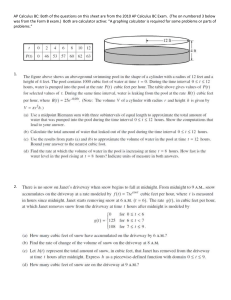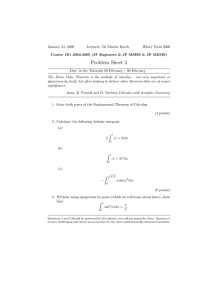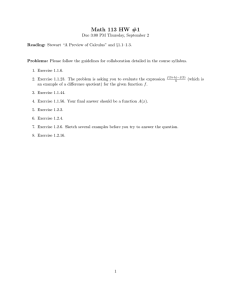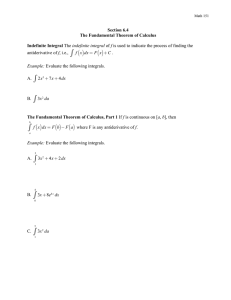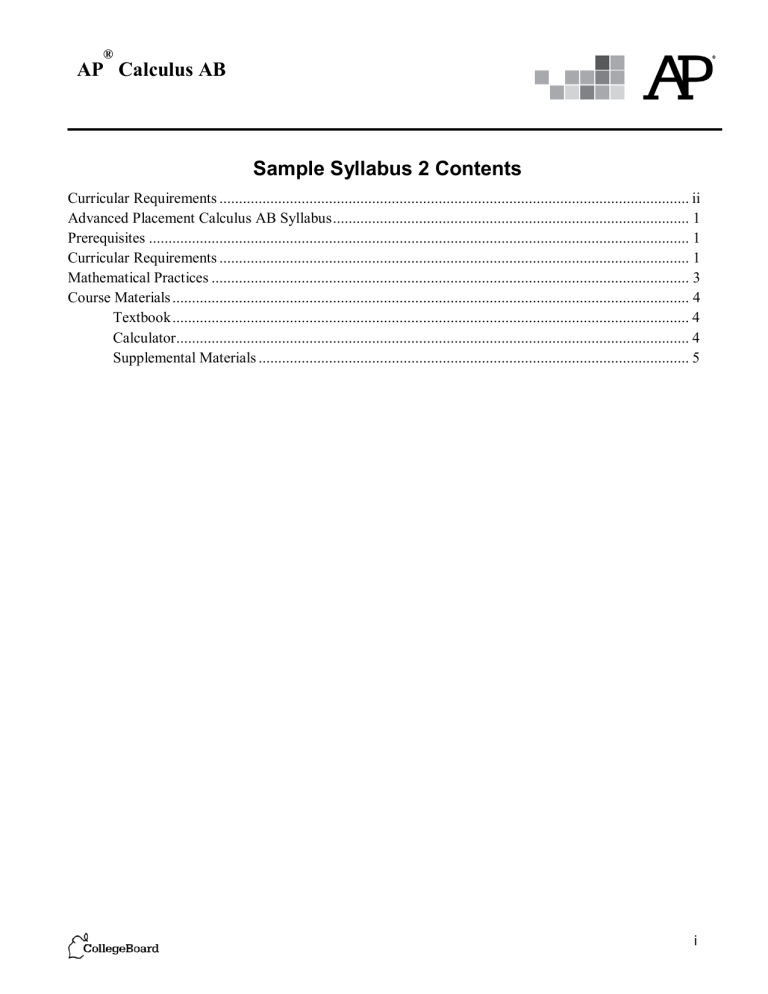
® AP Calculus AB Sample Syllabus 2 Contents Curricular Requirements ........................................................................................................................ ii Advanced Placement Calculus AB Syllabus ........................................................................................... 1 Prerequisites .......................................................................................................................................... 1 Curricular Requirements ........................................................................................................................ 1 Mathematical Practices .......................................................................................................................... 3 Course Materials .................................................................................................................................... 4 Textbook .................................................................................................................................... 4 Calculator ................................................................................................................................... 4 Supplemental Materials .............................................................................................................. 5 i ® AP Calculus AB Curricular Requirements CR1a The course is structured around the enduring understandings within Big Idea 1: Limits. • See pages 1, 5 CR1b The course is structured around the enduring understandings within Big Idea 2: Derivatives. • See pages 1, 2 CR1c The course is structured around the enduring understandings within Big Idea 3: Integrals and the Fundamental Theorem of Calculus. • See page 2 CR2a The course provides opportunities for students to reason with definitions and theorems. • See page 3 CR2b The course provides opportunities for students to connect concepts and processes. • See page 3 CR2c The course provides opportunities for students to implement algebraic/computational processes. • See page 3 CR2d The course provides opportunities for students to engage with graphical, numerical, analytical, and verbal representations and demonstrate connections among them. • See pages 3, 4 CR2e The course provides opportunities for students to build notational fluency. • See page 4 CR2f The course provides opportunities for students to communicate mathematical ideas in words, both orally and in writing. • See page 4 CR3a Students have access to graphing calculators. • See page 4 CR3b Students have opportunities to use calculators to solve problems. • See page 4 CR3c Students have opportunities to use a graphing calculator to explore and interpret calculus concepts. • See page 4 CR4 Students and teachers have access to a college-level calculus textbook. • See page 4 ii AP® Calculus AB: Sample Syllabus 2 Syllabus 1544591v1 Advanced Placement Calculus AB Syllabus Prerequisites Successful completion of the following yearlong courses: 1. 2. 3. 4. Algebra 1 Geometry Algebra 2 (which includes analytic geometry and logarithms) Precalculus (which includes elementary functions and trigonometry) Curricular Requirements An outline of the topics discussed and practiced in the course. I. II. Limits and Continuity [CR1a] 1. Evaluating limits a. Limits evaluated from tables b. Limits evaluated from graphs c. Limits evaluated with technology d. Limits evaluated algebraically i. Algebraic techniques ii. The Squeeze Theorem e. Limits that fail to exist 2. Limits at a point a. Properties of limits b. Two-sided limits c. One-sided limits 3. Continuity a. Defining continuity in terms of limits b. Discontinuous functions i. Removable discontinuity ii. Jump discontinuity iii. Infinite discontinuity c. Properties of continuous functions i. The Intermediate Value Theorem ii. The Extreme Value Theorem 4. Limits involving infinity a. Asymptotic behavior b. End behavior [CR1a] — The course is structured around the enduring understandings within Big Idea 1: Limits. Differential Calculus [CR1b: derivatives] 1. Introduction to derivatives a. Average rate of change and secant lines b. Instantaneous rate of change and tangent lines c. Defining the derivative as the limit of the difference quotient d. Approximating rates of change from tables and graphs 2. Relating the graph of a function and its derivative 1 AP® Calculus AB: Sample Syllabus 2 Syllabus 1544591v1 3. Differentiability a. Relationship between continuity and differentiability b. When a function fails to have a derivative 4. Rules for differentiation a. Polynomial and rational functions b. Trigonometric functions c. Exponential and logarithmic functions d. Inverse trigonometric functions e. Second derivatives 5. Methods of differentiation a. The chain rule b. Implicit differentiation c. Logarithmic differentiation 6. Applications of derivatives a. Velocity, acceleration, and other rates of change b. Related rates c. The Mean Value Theorem [CR1b: Mean Value Theorem] d. Increasing and decreasing functions e. Extreme values of functions f. Local (relative) extrema g. Global (absolute) extrema h. Concavity i. Modeling and optimization j. Linearization k. Newton’s method l. L’Hospital’s Rule [CR1b] — The course is structured around the enduring understandings within Big Idea 2: Derivatives. III. Integral Calculus [CR1c: integrals] 1. Antiderivatives and indefinite integrals 2. Approximating areas a. The rectangle approximation method b. Riemann sums c. The trapezoidal rule 3. Definite integrals and their properties 4. The Fundamental Theorem of Calculus a. The First Fundamental Theorem of Calculus [CR1c: Fundamental Theorem of Calculus part 1] b. The Second Fundamental Theorem of Calculus [CR1c: Fundamental Theorem of Calculus part 2] c. The Mean Value Theorem for integrals d. Average value of a function 5. Methods of integration a. Algebraic manipulation b. Integration by substitution 6. Solving differential equations a. Separation of variables b. Slope fields 2 AP® Calculus AB: Sample Syllabus 2 Syllabus 1544591v1 7. Applications a. Exponential growth and decay b. Particle motion c. Area between two curves d. Volumes i. Volumes of solids with known cross sections ii. Volumes of solids of revolution [CR1c] — The course is structured around the enduring understandings within Big Idea 3: Integrals and the Fundamental Theorem of Calculus. Mathematical Practices The following is a brief description of some of the activities included in the course. I. II. Reasoning with definitions and theorems LO 1.2B - In problems where students practice applying the results of key theorems (e.g., Intermediate Value Theorem, Mean Value Theorems, and/or L’Hospital’s Rule), students are required for each problem to demonstrate verbally and/or in writing that the hypotheses of the theorems are met in order to justify the use of the appropriate theorem. For example, in an in-class activity, students are given a worksheet that contains a set of functions on specified domains on which they must determine whether they can apply the Mean Value Theorem. There are cases where some of the problems do not meet the hypotheses in one or more ways. [CR2a] [CR2a] — The course provides opportunities for students to reason with definitions and theorems. Connecting concepts and processes LO 3.3A - Students are provided with the graph of a function and a second function defined as the definite integral of the graphed function with a variable upper limit. Using differentiation and antidifferentiation, students evaluate specific values of the second function and then find the intervals where the integral function is increasing, decreasing, concave up, and concave down. They use this information to sketch a rough graph of the second function. [CR2b] [CR2d: graphical] [CR2b] — The course provides opportunities for students to connect concepts and processes. [CR2d] — The course provides opportunities for students to engage with graphical, numerical, analytical, and verbal representations and demonstrate connections among them. III. Implementing algebraic/computational processes LO 3.2B - Students are presented with a table of observations collected over time periods of different lengths (e.g., temperatures or stock prices). Students use Riemann sums to numerically approximate the average value of the readings over the given time period and interpret the meaning of that value. [CR2c] [CR2d: numerical] [CR2c] — The course provides opportunities for students to implement algebraic/computational processes. [CR2d] — The course provides opportunities for students to engage with graphical, numerical, analytical, and verbal representations and demonstrate connections among them. IV. Connecting multiple representations LO 2.3C - Students are presented with numerous functions modeling velocity and time for objects in motion. These functions are presented numerically, graphically, analytically (in the form of a formula), and verbally (as a description in words of how the function behaves). Many of these functions are distinct, but some represent the same function (e.g., one of the functions presented verbally is the same as one of the functions presented analytically). Given some initial conditions, students calculate or approximate 3 AP® Calculus AB: Sample Syllabus 2 Syllabus 1544591v1 displacement, total distance travelled, and acceleration for these functions (both by hand and with a graphing calculator), and determine which representations are the same function. Students evaluate how each representation was useful for solving the problems. [CR2d: connection between analytical and verbal] [CR3b] [CR2d] — The course provides opportunities for students to engage with graphical, numerical, analytical, and verbal representations and demonstrate connections among them. [CR3b] — Students have opportunities to use calculators to solve problems. V. Building notational fluency LO 3.5B - Students are given a variety of growth and decay word problems where the rate of change of the dependent variable is proportional to the same variable (e.g., population growth, radioactive decay, continuously compounded interest, and/or Newton’s law of cooling). Students are asked to translate the problem situation into a differential equation using proper notation. Students show the steps in solving the differential equation, continuing to use proper notation for each step (e.g., when to keep or remove absolute value). In a later activity, students will vary initial conditions and use their calculators to graph the resulting solutions so that students can explore the effect of these changes. [CR2e] [CR3c] [CR2e] — The course provides opportunities for students to build notational fluency. [CR3c] — Students have opportunities to use a graphing calculator to explore and interpret calculus concepts. VI. Communicating Throughout the course, students are required to present solutions to homework problems both orally and on the board to the rest of the class. On at least one question on each quiz and test, students are explicitly instructed to include clearly written justifications in complete sentences for their solutions. [CR2f] [CR2f] — The course provides opportunities for students to communicate mathematical ideas in words, both orally and in writing. Course Materials Textbook Larson, Ron, and Paul Battaglia. Calculus for AP®. 1st edition. Cengage Learning, 2017. [CR4] [CR4] — Students and teachers have access to a college-level calculus textbook. Calculator A TI-Nspire CX Graphing Calculator is required of all students and will be provided by the school. Use of the calculator by students to solve problems includes, but is not limited to, plotting and analyzing the graphs of functions within an arbitrary viewing window, finding the zeros of functions, finding the limit of a function at a specific value, and analytically and numerically calculating both the derivative of a function and the value of a definite integral. [CR3a] Another major use of graphing calculators is in labs to “discover” some of the concepts and principles at work by experimenting with the various function representations and approaches to their solutions. Calculator lab topics include the following: Developing an intuitive understanding of limits Investigating the Intermediate Value Theorem Defining the slope of a function at a point by zooming in 4 AP® Calculus AB: Sample Syllabus 2 Syllabus 1544591v1 Relationship between a function and its derivative Linking up with the chain rule Exploring exponentials Newton’s method Riemann sums and the definite integral Average value of a function Numerical integration [CR3a] — Students have access to graphing calculators. Supplemental Materials Stewart, James. Single Variable Calculus. 7th edition. Brooks/Cole, Cengage Learning, 2012. Rogawski, Jon and Ray Cannon. Rogawski’s Calculus for AP* Early Transcendentals. 2nd edition. W.H. Freeman and Company, 2012. 5

